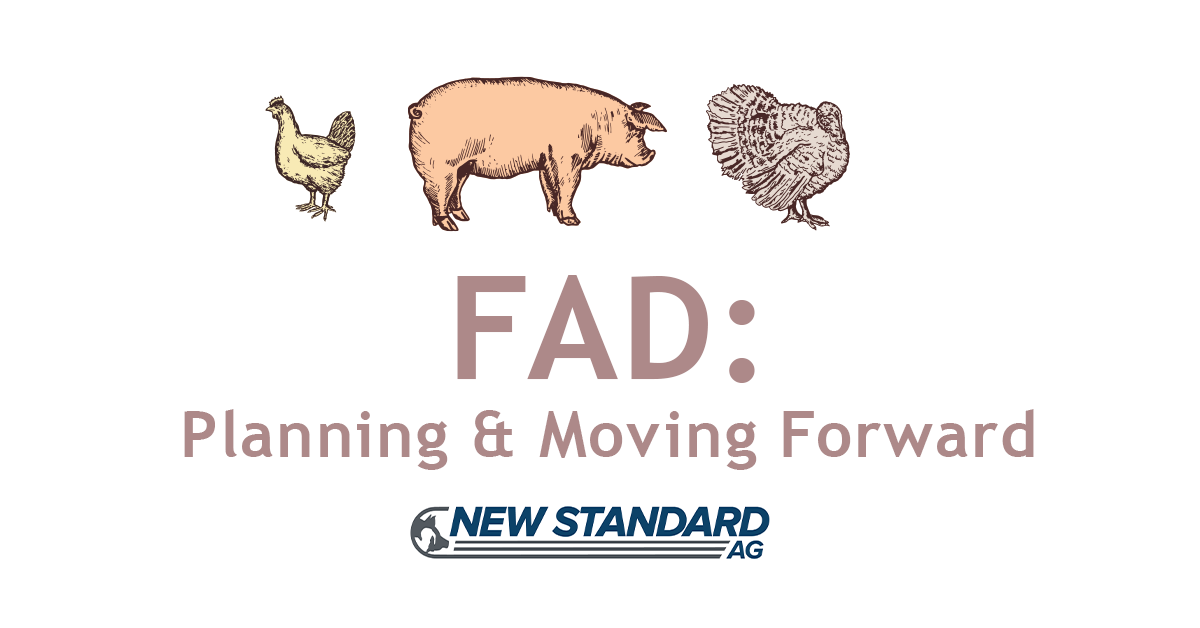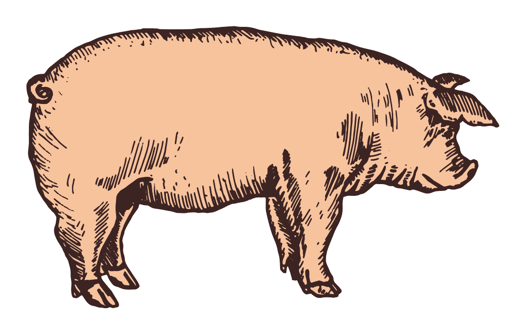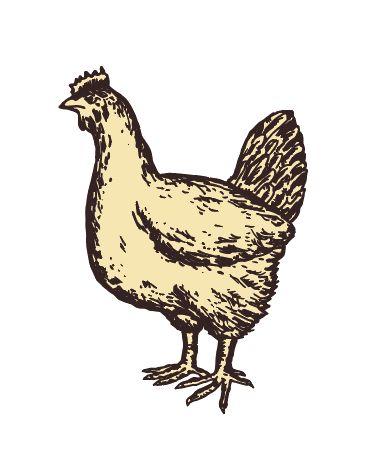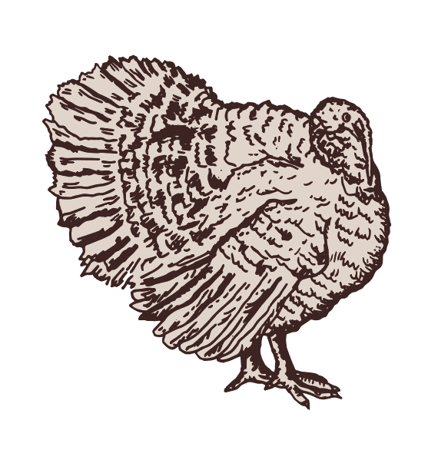
Foreign Animal Disease outbreaks (FADs), hard to think about and harder to talk about. However, the reality is this… having conversations now can save a lot of frustration and effort later.
This summer, we attended one of the many great talks at the World Pork Expo in Des Moines. The topic was Foreign Animal Disease: Depopulation and Disposal. The talk focused on the importance of having a well written emergency plan.
We’ve decided to expand on this topic to also cover our friends in the poultry world as there is a lot of crossover but a few high level differences to consider. Please keep the following in mind as you read this article.
Poultry farm ownership is much more integrated when it comes to the animals life cycle. Often birds are hatched, raised and processed within the same ownership network. This integration means less transportation needs, less transportation means less potential exposure. Also, poultry barns are built so larger machinery can get inside, to make compost piles and allow for easier carcass management if a FAD outbreak occurs.
Pigs typically move 3 times in their lives, sow farm to nursey, nursery to finisher and finisher to the slaughter house. Opening up the potential for a FAD exposure. In addition, FAD planning in hog dense area of the Midwest can become more challenging. For example, a hog finisher on a small piece of land may have limited options. Having a FAD plan for every location is important to the success of your plan.
From beginning to end, a Foreign Animal Disease outbreak can undoubtedly be one of the most stressful events a producer might face. Working out a realistic, suitable emergency plan can make a world of difference to deal with the threat and working towards a successful conclusion to the situation. Advance thought and preparation lead to cooler heads, easing tension and finding solutions to problems.
Planning
“The man who is prepared has his battle half fought.” -Miguel De Cervantes.
 Knowing what steps to take is crucial when starting your plan. An excellent starting place is with a phone call to your state veterinarian. They will be familiar with local regulations, what a response will look like, and more. They, and their staff, are here to help. Collaboration is vital to each plan. Collaborators will likely include your farm veterinarian, your state animal health/industry board, your nutritionist, health consultants, and the National Animal Health Laboratory Network (NAHLN). These folks are here as resource’s to assisting in successfully executing your plan and help get you back up and running as quickly as possible.
Knowing what steps to take is crucial when starting your plan. An excellent starting place is with a phone call to your state veterinarian. They will be familiar with local regulations, what a response will look like, and more. They, and their staff, are here to help. Collaboration is vital to each plan. Collaborators will likely include your farm veterinarian, your state animal health/industry board, your nutritionist, health consultants, and the National Animal Health Laboratory Network (NAHLN). These folks are here as resource’s to assisting in successfully executing your plan and help get you back up and running as quickly as possible.
A standard response to a Foreign Animal Disease outbreak typically has five main steps: (it is important to understand that specific diseases may have different plans)
- Foreign Animal Disease Investigation for Disease Detection
- Federal and State Animal Health Incident Management and response
- Depopulation
- Disposal
- Cleaning and Disinfection
Within each of these steps, decisions need to be made by the producer in collaboration with the state and/or USDA. This is where that communication with your state veterinarian can help you prepare and get started.
Things To Consider When Forming Your Plan
The easy part is confirming an FAD outbreak with veterinary diagnostic laboratory test results; the more challenging part is noticing it before cross-contamination occurs. Having a strong relationship with an accredited veterinarian is vital; your veterinarian will be able to assist you through your FAD planning. Familiarize yourself and your workers with disease symptoms so you can take action quickly. Empower your workers to ask questions and report problems.
Once an outbreak is confirmed, the goal is to keep it contained and dispose of the threat as soon as possible to stop its spread and avoid further outbreaks.
Your plan will not match your neighbor’s plan. There is no one-size-fits-all recipe. Each operation has unique circumstances that require unique solutions. One place to start would be creating some continuity among your operations, simple as a contact list at each site, names and phone numbers for state vet, county offers, fire department, sheriff, farm staff, local human health, etc.
Methods of Depopulation
 Part of the FAD response plan for some diseases will include choosing the proper method(s) to depopulate your animals. Many factors must be weighed including but not limited to time constraints, worker safety, ownership, indemnity, number of swine, size of pigs, and animal environment. Again, your herd veterinarian is an invaluable resource for these decisions. Only AVMA approved methods of depopulation can be utilized.
Part of the FAD response plan for some diseases will include choosing the proper method(s) to depopulate your animals. Many factors must be weighed including but not limited to time constraints, worker safety, ownership, indemnity, number of swine, size of pigs, and animal environment. Again, your herd veterinarian is an invaluable resource for these decisions. Only AVMA approved methods of depopulation can be utilized.
- The National Pork Board and AVMA have done the most research on the following methods of depopulation.
- CO2, Carbon Monoxide
- Gunshot
- Penetrating Captive Bolt
- Sodium Nitrite
- Electrocution
- Foam: Nitrogen-filled and Water Based currently being researched as an approved method.
- Ventilation Shutdown: Contact your local state/area vet for more information
Each method has pros and cons; we encourage you to read up on each on the Pork Board website. Familiarize yourself with your options and develop plans for the type(s) of production on your farm. Two good resources are: www.avma.org/AVMA-Guidelines-for-the-Depopulation-of-Animals.pdf and https://porkcheckoff.org/pork-production-management/swine-health/euthanasia/
Carcass Disposal After Depopulation
Assuming depopulation is required for a given FAD, your emergency response plan must include carcass disposal. Finding the best disposal solution for your farm can cause some headaches. Disposal must happen on-site to contain the pathogen and prevent its spread.
The three most common options for disposal are:
- Incineration: High cost associated with equipment and fuel.
- Deep-Pit Burial - Large equipment is required and operating and renting costs can become prohibitive.
- Carbon Based - Whole Composting / Ground Composting and Shallow Burial with carbon
Composting type disposal options require carbon and depending on your local resources; this may not even be an option. Awareness of the amount of carbon needed and how to source it should be evaluated while writing your plan.
Methods of On-Farm Disposal: Pros & Cons
Here are some more important considerations as you choose a disposal method:
 State & Local Regulations
State & Local Regulations
Each state has its own rules about where you can bury or compost. Your animal health/industry board can help you navigate these regulations.
Virus Inactivation
How long will it take for the virus to die completely?
Available Real Estate
How much land do you have available for disposal? Remember, this land will be tied up until the virus is inactive.
Available Machinery
Making a compost pile versus doing deep burial will require different machinery and operators.
Distance to groundwater/surface water/well water:
You may not be able to bury or even compost in a location where water is too close.
Neighbor Restrictions
There maybe considerations with your neighbors and circumstances to consider
Electrical & Utilities
Overhead electrical lines and buried utilities may also come into the equation
Soil Types
Does a prospective burial site have soil conducive to burial or composting?
Topography
How feasible is burial or composing based on the location of your land?
Deed Restrictions
There may be restrictions in your deed about disposal restricting your options.
Key Producer Questions and Considerations
Clearly, there is a lot to process and review when creating a depopulation and disposal plan in case of an FAD outbreak. Here is a final outline of what questions to ask and consider when creating your action plan.
What are My Options?
Consider Animal Welfare & Biosecurity
What are my resources?
Consider your state animal health/industry board, farm veterinarian, nutritionist, equipment, real estate, and access to carbon and State regulations. These should be listed in your plan with contact information for ease of use when needed.
What are my next steps?
Finalize your plan with any approvals or sign-offs needed and educate your staff.
Who is responsible for Carrying Out my plan?
Knowing who is responsible for what task will help in a quick execution of your plan.
When will I review my plan?
Put a review date on your calendar and don’t let it pass without following up. Review your plan with your veterinarian and your workers.
Hopefully, you will never need to execute this plan, but if the day does come, you'll be ready.
Links and Additional Resources:
https://www.slideshare.net/porkcheckoff/planning-for-emergency-massdepopulation-of-swine




